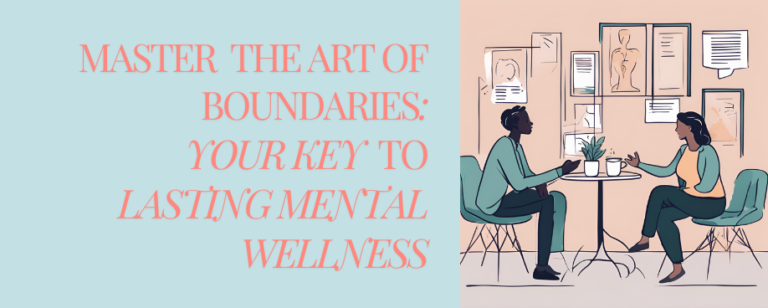In today’s fast-paced world, dominated by relentless schedules and demanding obligations, the importance of setting boundaries for our mental wellness is often overlooked. Yet, amidst the chaos, boundaries serve as essential tools for preserving our peace of mind and asserting our self-worth. For many of us, though, the prospect of setting boundaries can feel daunting and unfamiliar. We may doubt our ability to do so effectively or question whether we have the right to assert our needs. It’s crucial to recognize that boundaries are not only a form of self-care but also a means of nurturing healthy relationships and communities.
Whether in our personal lives, professional lives or even our own self-care habits, our unique needs for boundaries deserve acknowledgment and respect. In this article, I invite you to join me as we explore the art of boundary-setting and equip ourselves with the tools and strategies to establish, communicate, and enforce boundaries more confidently and comfortably than ever before. So, grab nice cup of tea or some other enjoyable drink and settle in! Let’s get into it and discover helpful practices that foster sustainable mental wellness and peace of mind.
STEP #1: Identify Your Need For Boundaries
The first step in setting healthy boundaries is recognizing when and where they are necessary. Whether it’s in your personal relationships, professional life, or self-care routines, pay attention to situations where you feel overwhelmed, stressed, or uncomfortable. These are often signs that a boundary needs to be established.
When we find ourselves feeling overwhelmed, it’s often because we’re taking on too much or neglecting our own needs in favor of others’. Similarly, stress can arise when we feel stretched thin, pulled in multiple directions, or faced with challenges that seem insurmountable. Discomfort, whether it manifests as resentment or dissatisfaction, is a clear indication that our boundaries have been ignored and our limits are not respected by others (or even by ourselves). All of these can lead to a depletion of our mental and emotional resources, making it critical to recognize the need for boundaries.
STEP #2: Take a Beat
STEP #3: Embrace Responsibility in Communicating Boundaries
Setting boundaries can be challenging, especially if you’re accustomed to putting others’ needs before your own or if you fear conflict or rejection. Many people find they feel uncomfortable or resentful for needing to blatantly draw them out for other people. The truth is that no one else can advocate for your needs as effectively as you can. Defining boundaries not only benefits you but benefits those with whom you interact. This even ripples out to friends and family.
Ultimately, accepting your responsibility for communicating needed boundaries may require a shift in mindset—an understanding that boundaries are not barriers to connection but rather bridges to healthier, more fulfilling relationships. By embracing this mindset and taking proactive steps to assert your boundaries you claim your sense of agency and self-worth.
STEP #4: Own Your Boundaries – USE “I” Language
Using “I” language allows us to take ownership of our feelings and needs without assigning blame or responsibility to others. By stating our boundaries in terms of our own experiences, we invite others to empathize with us and collaborate on finding mutually beneficial solutions. For example, instead of saying, “You make me feel overwhelmed,” which may come across as accusatory or confrontational, try saying, “I need some time alone to recharge.” This communicates your need for space and self-care without placing blame on the other person. “I” language is a powerful way of affirming your right to prioritize your own well-being and sets a clear expectation for how you wish to be treated.
STEP #5: There’s No Need to Explain Yourself
One of the most liberating aspects of boundary-setting is realizing that you don’t owe anyone an explanation for your boundaries. Your boundaries are valid simply because they are yours, and you have every right to assert them without feeling the need to justify or defend them. While it’s natural to want to explain our decisions to others, especially if we fear judgment or conflict, it’s important to recognize that doing so is entirely optional. Trust in the validity of your boundaries and remember that you are entitled to set them without justification. Your needs matter and honoring them is a powerful act of self-care and self-respect.
It’s also important to remember that boundaries are not up for negotiation. While others may push back or try to guilt-trip you into relenting, it’s essential to stand firm in your boundaries and prioritize your own well-being. You have the right to say no without feeling guilty or selfish, and asserting your boundaries is an act of self-respect, not a rejection of others.
STEP #6: Find Boundary-Setting Experts to Model
Find people who are good at setting boundaries and to really pay attention to how they communicate them confidently, assertively, without ever asking for permission, and without coming across as emotionally reactive. Model their approaches. Tune your ears to listen for those good boundary-setting phrases and practice them. You can make a list of phrases in the notes ap in your phone and pull them up to review, mentally rehearse and entrain them into your brain for easy recall when you need them. For example, when the next time someone asks for your time or assistance when you’re already stretched thin, you can say, “I’m unable to help with that right now,” without feeling compelled to offer a laundry list of reasons why.
BONUS TIP: Reward Yourself
Lastly, I want to encourage you to reward yourself for successfully setting boundaries. Every time you reward yourself and celebrate your accomplishments, big or small, and acknowledge the courage it takes to prioritize your mental wellness you are helping yourself to develop a sustainable habit more easily. Treat yourself to something nice as a reminder of your commitment to self-care and self-confidence.
And to this point, there is no better time than right now to get moving on your new “do-something-and-then-reward-thyself routine.” For I want to encourage you to go and high-five yourself in the nearest mirror to you, right after you read the very last sentence of this article and go on to prioritize your own well-being and cultivate a peaceful mind!
By following these six steps and embracing the bonus tip, you’ll be well on your way to mastering the art of setting healthy boundaries for sustainable mental wellness and inner peace.




